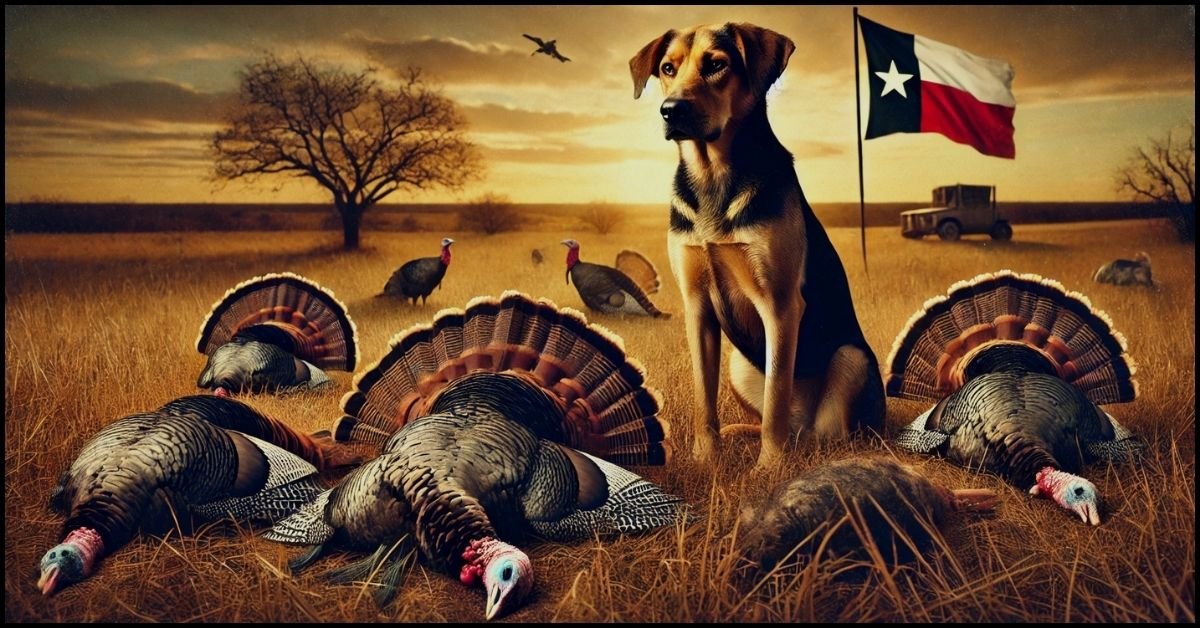Hunting in Texas is a revered tradition, with many outdoor enthusiasts spending years perfecting their craft. Whether it’s for deer, quail, or turkey, the thrill of the hunt is deeply embedded in the state’s culture. However, the story of how my Hunting Dog Killed My7 Turkey Texas serves as a sobering reminder of the potential dangers that can arise when animals are involved in the hunt.
While hunting dogs are often seen as invaluable companions, they also carry risks if not properly trained or controlled. In this article, we’ll break down the events of that fateful day, offer insights into how it all went wrong, and provide important lessons for hunters to consider when bringing their dogs into the field.
My Story: The Day My Hunting Dog Killed My7 Turkey Texas
It was a crisp fall morning in Texas. The sun was beginning to rise, casting a golden hue over the vast, sprawling plains. My hunting gear was all set, and my trusted bird dog, Max, was by my side. Max, a seasoned hunting dog, had accompanied me on numerous turkey hunts. I trusted him to help me flush out turkeys, locate them in the brush, and even retrieve them after a successful shot.
But that day, something went wrong.
The Setup: A Quiet Morning of Turkey Hunting
Hunting Dog Killed My7 Turkey Texas is a unique experience. It’s not just spotting your quarry; it’s about patience, stealth, and understanding the animal’s behaviour. My strategy was simple: set up in a secluded area known for frequent turkey sightings, use my calls to attract the birds, and wait for the perfect shot. Max was supposed to be my partner, helping locate any turkeys lurking in the nearby trees or underbrush.
Everything started as planned. I set up my blind near a known turkey roost and began calling. As usual, Max lay beside me, alert but calm. After an hour of calling, I heard rustling in the brush – the unmistakable sound of a turkey moving through the undergrowth. I motioned to Max, signalling him to stay quiet and wait for the perfect moment to flush the birds toward me.
The Incident: How It All Went Wrong
What happened next still haunts me. At the precise moment the turkeys were moving into range, Max, without any command from me, bolted from his spot and charged into the brush. In a split second, he had frightened all seven turkeys, causing them to scatter in every direction. In a high-energy panic, Max chased the birds as they took flight.
The turkeys didn’t stand a chance. My heart sank as I saw Max, in his excitement, grab one of the turkeys mid-flight. He was trained for retrieving, not chasing live games. In his eagerness, Max had not only flushed the birds but had gone after them with an uncharacteristic and dangerous force. Within moments, Max had killed one turkey. Before I could even react, the chaos unfolded further. He grabbed another, then another, until he had killed all seven of my turkeys.
The Aftermath: A Bitter Lesson
I stood there in stunned silence, watching as Max stood proudly over the pile of turkeys, not understanding the magnitude of the damage he had caused. The day that was supposed to be a rewarding and productive hunting experience had turned into a disaster. I had not only lost the turkeys I had spent hours scouting but also found myself facing an ethical dilemma. Max’s instincts had been triggered, but it was clear that his training had fallen short when it mattered most.
What was supposed to be a controlled hunt had turned into a lesson in the unpredictability of animals and the importance of responsible dog ownership and hunting practices. This experience was a wake-up call for me and a stark reminder that even the most trusted hunting dogs need constant training and supervision.
Lessons Learned: What Went Wrong and How to Prevent It
This unfortunate event was a turning point in how I approach turkey hunting, especially when it involves my dog. It’s important to understand that hunting with dogs has challenges. The bond between hunter and dog can be incredibly rewarding but requires discipline, preparation, and responsibility. Below are the key lessons I learned from this experience.
- Proper Training is Crucial
One of the most important takeaways from this incident is the necessity of ongoing training for hunting dogs. Max was a great dog, but in hindsight, I realized his training had been incomplete in certain areas. While he was good at retrieving, he had not been sufficiently trained to handle the excitement of a turkey hunt or to recognize when to hold back.
To prevent such incidents, training should include:
- Obedience drills: Ensuring your dog knows commands like “stay,” “wait,” and “leave it” can be the difference between a controlled hunt and chaos.
- Desensitization: Gradually exposing the dog to live games (under controlled circumstances) can help prevent overexcitement and aggression.
- Behavioural cues: Teach the dog to recognize the signs of a hunt in progress and stay calm during those crucial moments.
- Understanding Your Dog’s Instincts
Even the best-trained hunting dogs are driven by instinct, and understanding these instincts is key to ensuring a safe and productive hunt. Dogs are highly attuned to their environment, and the excitement of the hunt can sometimes override the commands you’ve given them. Max’s instincts as a retriever kicked in, but this didn’t help in a situation that required more control.
By recognizing the natural behaviours of hunting dogs, you can:
- Avoid situations that may lead to overexcitement.
- Manage their energy levels before and during a hunt.
- Set clear boundaries that prevent the dog from overstepping its role.
- Supervision is Key
No matter how well-trained your dog is, you should always keep a close watch during the hunt. The split-second moment of hesitation can result in irreversible consequences. I learned this the hard way: trusting Max too much without close supervision led to destroying the turkeys I had worked so hard to attract.
The following tips can help:
- Please keep your dog on a leash when entering a new area until it is under control.
- Use a whistle or other commands to regain control when the dog gets excited.
- Maintain a proactive role during the hunt and avoid distractions.
- Ethical Considerations
This experience also made me reflect on the ethical side of hunting. While hunting is legitimate, ensuring it is conducted respectfully and responsibly is essential. The loss of seven turkeys due to poor handling and lack of control was frustrating and made me consider the moral implications of such an event.
Key ethical points to keep in mind:
- Always aim for a clean, humane shot that avoids unnecessary suffering for the animal.
- Be aware of your surroundings and how your actions (or your dog’s actions) may affect the environment.
- Ensure that any hunt aligns with local laws and regulations, including those related to bag limits and conservation efforts.
- Consider the Impact of Technology
With more advanced technology, such as GPS tracking collars and cameras, managing your hunting dog’s movements has become easier. While not a foolproof solution, these tools can give you real-time insight into where your dog is and what it’s doing, helping you avoid potential disasters like the one I experienced.
Investing in tracking technology:
- Provides better oversight of your dog’s location and activities.
- It can help you keep your dog in line without constant physical supervision.
- It improves your ability to respond quickly if something goes wrong.
People Also Ask about Hunting Dog Killed My7 Turkey Texas
- Can hunting dogs be trained not to chase turkeys?
With proper training, hunting dogs can learn to control their impulses and avoid chasing turkeys or other wildlife. This involves desensitization, positive reinforcement, and clear commands to ensure the dog understands its role in the hunt.
- What should I do if my hunting dog chases or kills a turkey?
If your dog chases or kills a turkey, stop the hunt immediately. Assess the situation and work on retraining your dog to address the behaviour. Learning from the mistake and preventing it from happening again is essential.
- Are there any special precautions I should take when Hunting Dog Killed My7 Turkey Texas?
In Texas, ensure your dog is trained for the game you’re hunting. Texas also has various regulations for hunting seasons, bag limits, and protected species, so make sure your dog’s training aligns with these rules. Additionally, please keep your dog hydrated and monitor its condition in the field.
- What are the risks of hunting with untrained dogs?
Untrained dogs can cause chaos in the field, including scaring off game, attacking wildlife, or even getting injured. Hunting with a dog that’s not properly trained can also lead to legal issues, especially if you cannot control your dog’s behaviour during a hunt.
- How can I prevent my hunting dog from harming the game?
To prevent your dog from harming the game, provide consistent training, use obedience commands, and supervise your dog closely during hunts. Using tracking collars or GPS systems can also help ensure better control and prevent the dog from wandering off or getting overly excited.
Conclusion: The Importance of Control and Responsibility
The day my Hunting Dog Killed My7 Turkey Texas was a wake-up call for me. It underscored the importance of training, supervision, and understanding the instincts of hunting dogs. While the incident was frustrating, it ultimately made me a more responsible and careful hunter. Remember that control, communication, and ethical behaviour are paramount if you’re heading out into the field with your dog. By learning from mistakes and continuously improving, you can ensure your hunting trips are safe and successful for you, your dog, and the wildlife you’re pursuing.

Zoe Rae is a dynamic writer at SpinUpBusiness.com, where she covers a broad range of topics from business strategies to lifestyle, technology, and more. With a keen eye for detail and a passion for making complex ideas simple, Zoe crafts content that informs, engages, and inspires her readers.



